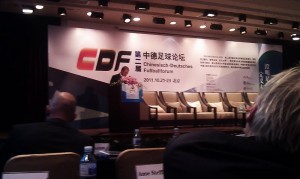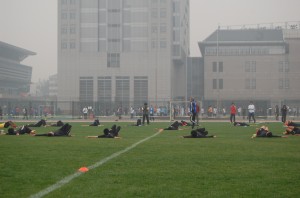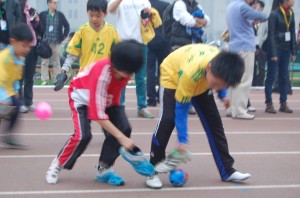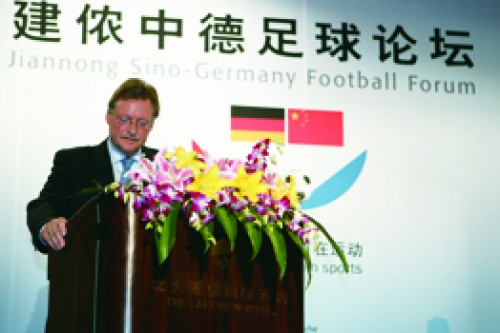A strategic partnership between the Deutsch Fussball Federation (German FA) and the CFA broke ground at the second Sino-German Football Forum in Beijing last Saturday. The meeting, designed to highlight key developmental issues in Chinese and German football, covered a wide variety of topics ranging from early youth to the national team level football development. Notable speakers were Liu Jianhong (the current lead commentator for CCTV5 football matched) Dr. Walter Tokarski (President of German Sport School in Cologne) Dr. Jurgen Buschmann (Chief of German National Team Research and Development Group in Cologne), Pierre Littbarski (Assistant coach at Vfl Wolfsburg and 1990 World Cup Champion) and Lin Xiahu (Vice President of CFA). The event, hosted by Beijing University, covered two days of lectures, discussions, demonstrations, and a friendly match.

An alliance in the making. German and Chinese Football powers unite to develop the soccer industry, culture, and playing level in China.
Day One: Introductions and Background Info
Following the obligatory opening ceremony and endless introductions (TIC) Dr. Walter Tokarski spoke of the “Golden Plan” in Germany. Initiated in the 1950’s the plan was supported and managed by the German government (central and local) and designed to develop the hierarchy of the German football pyramid. With clear goals and effective training methods (for players and coaches themselves) this system has produced arguably the most consistently successful national team in the world. One has to look no further than the last three world cups where Germany finished 3rd twice (2006, 2010) and 2nd (2002) thus playing the maximum number games in each tournament. No other national side can boast such consistent performances over three world cups held in three different continents.
After being informed of how and why Germany soccer is so glorious, the next speaker furthered this trend and gave a comparison of football facilities, infrastructure and investment between Germany and China. Needless to say the stark contrast of both quantity and quality of football infrastructure was evident. Littbarski then introduced the Vfl Wolfsburg training system under renowned German coach Felix Magath. Having a disciplined training regimen and setting individual goals for players is the underlying theme in Magath’s coaching style. Finishing the day’s round of speeches was Buschmann who focused on the successful achievement and business model of the German National Team. Unlike the guojiadui, the Germans make money as they play football internationally, despite the Germans investing over 200% more capital than Chinese throughout their soccer system. In summary, the lectures were quite easy to understand, even if languages were German and Chinese. The common denominator throughout all was – German football has a great model, and China has much to learn.

Littbarski (Wolfsburg Vfs and former 1990 FIFA World Cup Champion leads a group of Chinese players in the 'Magath Method'
The afternoon featured a host of VIP’s participating in an open discussion. International administrators, professors, media representatives, referees, and other recognized individuals shared their thoughts and opinions on the challenges and realities of Chinese football. The focus hardest questions were how to transfer the success from the German soccer system into Chinese circumstances, and how to popularize the sport. However, since there was two days of preparation before the meeting, the mood was hardly heated while negligent of pressing issues. Much of the comments seemed premeditated and easy quotations for press.
Day Two: Thinking outside the Chinese box
Saturday presented another line of speeches. The first introducing the Chinese youth football system. Overall the statistics showed many amazing ‘facts’ how underdeveloped the Chinese football infrastructure remains. This included the statement that there are no amateur teams in China (I coach and play at an organized amateur Chinese football team fyi…see www.sinobalfootball.com for more info). Then came a rather interesting speech from Dr. Daniel Memmert of Cologne Sport School. First his presentation demonstrated the impressive research and analysis documenting the development of the sport in the last 50 years. Major changes shown from Fifa World Cup match data demonstrate that, on average, todays international players shoot less, yet run (distance and top speed sprints) pass, and dribble more than players 20 years ago. Later on the presentation covered innovative methods using media and games to effectively introduce ball sports to Children in a playful, engaging, and creative manner. Yet, the most interesting parts of the lecture shown were famous cognitive psychology videos of concentration and focus. . If you haven’t seen them before check them out and be amazed.
THE INVISIBLE GORILLA – selective attention test
Amazing Color Changing Card Trick
The videos suggest those heavily involved with Chinese football may not be able to see the ‘invisible gorilla’ or novelty in the room. Only an outsiders eye (ahem…like ) can grasp who and what is manipulating the shades and colors, and for what purpose. (See video for odd references, one is youtube).

Children play a game of shoe ball in the developmental aspect of 'Ball schule' or Ball School developed in the German Sport School of Cologne.After lunch break we finally headed to the fields where Littbarski demonstrated a Wolfsburg Vfs training session with a local Beijing high school team. Followed by Dr. Memmert who led a group of young children in basic skill, team concepts, and fun games in what wasdubbed ‘personality and creativity’ development. Last Dr. Buschmann demonstrated Cooperation and Training in Sports again with the high school group. The event ended with a friendly match featuring the German guests and the Chinese hosts. Littbarski showed his World Cup prowess marking a goal and an assist in a 3-1 victory for the visitors.
Overall the press generated from such an event will garnish positive attention and hopefully support for the CFA and its long term operations. The professional and scientific models of German football shared present many administration and R&D capabilities that will no doubt boost the Chinese football development system. However, the circumstances and obstacles the Chinese football system face are not necessarily because of a lack of what the Germans are offering. Aspects neglected in the forum are the reality that the education system does not encourage or even allow most children to play recreationally and cultivate their football talents or even interest in the sport. And still few Chinese Super League, and almost no lower division, Chinese clubs are able to turn a profit from their football operations.
Nor was addressed the issue of keeping a long term national team coach who can help establish a system that leaves a legacy to build off. Recent evidence of changing coaches (often mid campaign) shows that the focus of the entire sport is mere immediate gratification. Those that fail to win are replaced, while a new incoming coach with a new system starts all over again from ground zero. Still, we are reminded that Chinese football is in its infancy, unable to even identify with its own style or brand of the game. However, even if you can teach a young dog new tricks, can you get it to stop chasing its tail? Time will tell if this union between German and Chinese Football will yield a positive impact for the sport.

wait the national team doesn’t get paid???……..
is this some sort of joke?
i know how to improve the team already…bonus per goal
I think the point is the Germans invested billions of dollars throughout the national team (both men’s and youth~~U19, U17, U15) as well as the youth (as early as 5 years old) for the last 50 years. China has invested less overall and mostly focused only on the men’s national team.
Pingback: Asics Asics femme